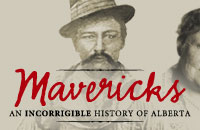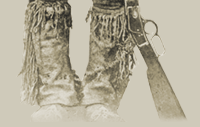 |

[ Project Plans | Essential
Questions | Knowledge Hunt | Glossary | Links ]
The Real Story of Arriving in Canada
Conducting Oral History Interviews to Tell the Story of Your Family's
Immigration to Canada
Introduction
Students need to understand how Canada is made up of a majority
of immigrant families from all over the world. It is the stories
of these people, their way of life over time, and their diversity
of experience that make up the Canadian identity. Where did their
family come from? How did they get here? Why did they leave their
original country? Why did they come here? What was their life like
in their new home?
Project Explanation
In this project, students will develop an appreciation of the "social
history" of Canada by looking at their family's history
and demonstrate an understanding of the events and factors that
have changed the way of life in Canada over time and appreciate
the impact of these changes on the way we live. Students will gather
details about a family story by interviewing one of their relatives,
which will allow students to gain a greater understanding of their
family and where they came from. The results will be used to write
a narrative story that they will present as a storyteller in front
of their class.
Alberta Social Studies Curriculum Unit Connections
Grade Four - Alberta: The Land, Histories and Stories
4.2 The Stories, Histories and People of Alberta
4.3 Alberta: Celebrations and Challenges
Grade Five - Canada: The Land, Histories and Stories
5.2 Histories and Stories of Ways of Life in Canada
Grade Seven - Canada: Origins, Histories and Movement of People
7.2 Following Confederation: Canadian Expansions
Materials and Resources Needed
Procedures
Gathering a family's history through the stories older relatives
can share allows students to spend quality time with their family,
but also have the time to ask questions about the past. Students
will create tell an oral story from their family history after interviewing
one of their relatives for ideas. If they come from a First Nations
background, they will try to find out details of how their family
lived before Europeans came to North America or how their way of
life changed in some way when numerous cultures came together. If
their family immigrated to Canada from another country, they will
try to find out details of how their family arrived in the province
of Alberta, and some of the difficulties faced by people immigrating
to Canada. Teachers can begin the project by sharing stories from
their own family's past and modeling what the final projects
will look like.
Students will begin by examining some of the stories of the "Newcomer"
Mavericks that immigrated to Canada in the Mavericks: An Incorrigible
History of Alberta site. This will allow them to look at what
other families went through when they came to Canada, and what they
faced once they got here. Students will then begin to brainstorm
potential questions that they could ask a relative in order to find
out information about their family. Where did they come from? How
did they get here? Why did they leave their original country? What
were some of the difficult things our family had to cope with? What
was life like?
The students will need to search for an anecdotal story that shares
a short span of one journey, event, experience, or milestone. It
may be the actual trip to Canada, how a set of grandparents met,
a difficult job, how the family made it once they were here, or
even living through wartime. The students will not be sharing dates,
times and locations, as they will be creating a narrative with their
family members as the characters.
When ready, students will interview a family member in person,
over the phone, or using the computer, and attempt to find an interesting
story that relates to how their family came to Canada. They will
try to get as much detail as possible, using questions to ask about
who, what, where, when and why. They will want to know what the
places looked like, what the people were like, how they acted, and
how they may have felt at the time.
Once they have completed the interview, they will begin to write
the story in the style of historical fiction, using the details
they have gotten from the interview. If they do not know specific
details that are needed, they may need to "fill in the blanks"
with appropriate information. As they will be performing in the
role of "storyteller" for their classmates, they will
need to write the story so that it is "told" rather
than "read." They will want to add emphasis to words,
make it sound very personal, and express feeling and emotion when
telling it.
To add to the telling of their story, students should bring in
props to attract the attention of their audience. They may bring
in one (or more) primary family artifacts or photographs that are
from the time of their story (make sure they ask for permission).
They may also create puppets, costumes, props, posters, illustrations,
or maps that will help their audience understand the story they
tell. After practicing at home or school, the students will present
in front of the class. Parents may be invited to watch if the teacher
chooses.
Assessment and Evaluation
- After the teacher and students collaboratively create a rubric,
students should use it as a guide for their learning as they are
working through the process, regularly checking that all the needed
elements are included in their work and revising as needed. The
rubric can then be used as a formal evaluative tool when they
have completed their project.
- Students may use their rubric as a guide for writing a self-assessment
of their project work. They will determine their level for each
of the categories and use the criteria specified in their rubric
to justify them.
- A project journal may be used for information gathering as well
as for reflective writing as the process is taking place. Students
can pose questions, vent frustrations, synthesize their work,
examine their process, and even wonder about what they are missing
or what is still needed for their project. This may be completed
as a group or individually.
- After completing the project, students may talk or journal about
what they felt they did very positively, what they had difficulty
with, and how they would change how they would approach a similar
project in the future.
Ideas for Enriching this Project
- Students may work on creating a "family tree" that
will cover a few generations while conducting the interview.
- Students could take on the role of the main character, and actually
act like they are their grandmother or grandfather as they tell
the story to the class.
 |



![]()
